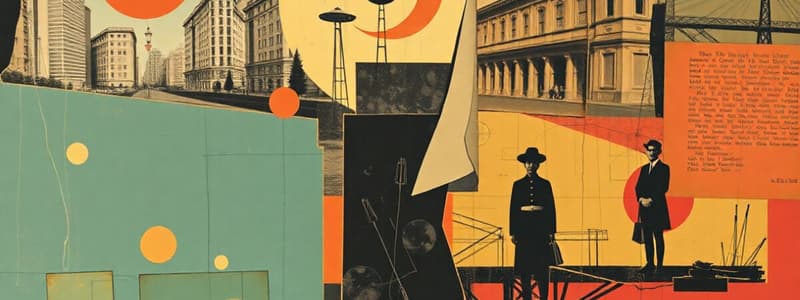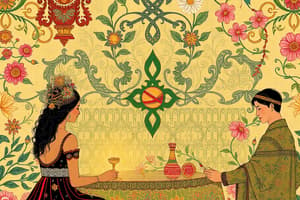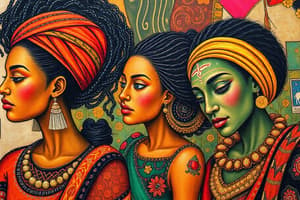Podcast
Questions and Answers
What has conditioned our understanding of art according to the content?
What has conditioned our understanding of art according to the content?
- Global cooperation of artists
- Technological advancements in art tools
- Diverse cultural expressions in art
- Prejudiced notions concerning race and gender (correct)
Which of the following is NOT listed as an assumption of the dominant Western fine art canons?
Which of the following is NOT listed as an assumption of the dominant Western fine art canons?
- Great art is made by community collaboration (correct)
- Oil painting is the most important art form
- There is a significant hierarchical distinction between art and craft
- The best art has been produced by European males
What must be set aside to effectively discuss racism and prejudice in art education?
What must be set aside to effectively discuss racism and prejudice in art education?
- Bias and preconceived notions
- Fear, anxiety, and timidity (correct)
- Confidence and assertiveness
- Curiosity and openness
What has been one effect of the dominance of Western artistic canons?
What has been one effect of the dominance of Western artistic canons?
According to the content, how is ethnocentrism related to racism?
According to the content, how is ethnocentrism related to racism?
What is stated about the study of art being decontextualized?
What is stated about the study of art being decontextualized?
What does the content suggest is necessary for educating students in a multicultural society?
What does the content suggest is necessary for educating students in a multicultural society?
What primary role should art teachers fulfill in a multicultural classroom?
What primary role should art teachers fulfill in a multicultural classroom?
Which significant event contributed to the development of multicultural approaches to art education in the United States?
Which significant event contributed to the development of multicultural approaches to art education in the United States?
What is an essential aspect of effective art education in a multicultural context?
What is an essential aspect of effective art education in a multicultural context?
Which publication has played a role in keeping multiethnic issues alive in the field of art education?
Which publication has played a role in keeping multiethnic issues alive in the field of art education?
What type of curriculum materials are needed in multicultural art education?
What type of curriculum materials are needed in multicultural art education?
What does Hume suggest about the contributions of non-white individuals to civilization?
What does Hume suggest about the contributions of non-white individuals to civilization?
What was Linnaeus credited with regarding race classification?
What was Linnaeus credited with regarding race classification?
How were Jews, Catholics, and Protestants viewed according to the content?
How were Jews, Catholics, and Protestants viewed according to the content?
What stereotype was introduced to European and American readers in A History of Jamaica?
What stereotype was introduced to European and American readers in A History of Jamaica?
According to the content, which of the following groups was often excluded from the standards set by European males?
According to the content, which of the following groups was often excluded from the standards set by European males?
What major basis for judgment was identified regarding non-whites?
What major basis for judgment was identified regarding non-whites?
What impact did craniometry have on art education?
What impact did craniometry have on art education?
What aspect of Europeans’ view of art and craft is highlighted in the content?
What aspect of Europeans’ view of art and craft is highlighted in the content?
What conclusion can be drawn from the claims made about non-white individuals?
What conclusion can be drawn from the claims made about non-white individuals?
What attitude did the Houston Museum of Fine Arts hold towards black visitors during the 1930s?
What attitude did the Houston Museum of Fine Arts hold towards black visitors during the 1930s?
According to Zerffi, what was a common belief about the artistic abilities of different racial groups?
According to Zerffi, what was a common belief about the artistic abilities of different racial groups?
What was the underlying factor in Zerffi's views on art and ethnicity?
What was the underlying factor in Zerffi's views on art and ethnicity?
How did racism impact the viewing of art by African Americans?
How did racism impact the viewing of art by African Americans?
Which statement reflects Zerffi's perspective on artistic development?
Which statement reflects Zerffi's perspective on artistic development?
What does the term 'cosmical forces of nature' imply in Zerffi's discussion?
What does the term 'cosmical forces of nature' imply in Zerffi's discussion?
What does the phrase 'magic circle of the imagination' refer to in the context of art?
What does the phrase 'magic circle of the imagination' refer to in the context of art?
What effect did racism and power have on the perception of art and artists?
What effect did racism and power have on the perception of art and artists?
What misconception about artistic talent is expressed in Zerffi's comments?
What misconception about artistic talent is expressed in Zerffi's comments?
Which statement best characterizes the historical view of African Americans and art production?
Which statement best characterizes the historical view of African Americans and art production?
What stereotype was supported by geographic determinism regarding the performance of different races?
What stereotype was supported by geographic determinism regarding the performance of different races?
Which of the following statements reflects the views of Leclerc about beauty?
Which of the following statements reflects the views of Leclerc about beauty?
Who connected the idea of geographic determinism with the superiority of white Protestant races?
Who connected the idea of geographic determinism with the superiority of white Protestant races?
Which of the following regions did Leclerc identify as producing the most beautiful people?
Which of the following regions did Leclerc identify as producing the most beautiful people?
What impact did geographic determinism have on racial classifications in the 19th century?
What impact did geographic determinism have on racial classifications in the 19th century?
How did Marsden characterize the stereotypes of 'noble savage' and 'lazy native'?
How did Marsden characterize the stereotypes of 'noble savage' and 'lazy native'?
What was one claim made by Isaac Edwards Clarke regarding civilization?
What was one claim made by Isaac Edwards Clarke regarding civilization?
What does the term 'formalism' refer to in the context of multicultural art education?
What does the term 'formalism' refer to in the context of multicultural art education?
Why is the concept of geographic determinism considered problematic in the study of races?
Why is the concept of geographic determinism considered problematic in the study of races?
What quality did nineteenth-century racial rankings associate with different climates?
What quality did nineteenth-century racial rankings associate with different climates?
Flashcards
Eurocentric Bias in Art
Eurocentric Bias in Art
The belief that art produced by European males is superior and represents the only true standard of artistic excellence.
Dominant Art Canons
Dominant Art Canons
A set of established rules and values that define what is considered 'good' art, often based on Western European traditions.
Art & Craft Distinction
Art & Craft Distinction
The idea that fine art is superior to craft, often based on Western artistic hierarchies.
Individual Genius Myth
Individual Genius Myth
Signup and view all the flashcards
Formalist Aesthetics
Formalist Aesthetics
Signup and view all the flashcards
Ethnocentrism
Ethnocentrism
Signup and view all the flashcards
Multicultural Art Education
Multicultural Art Education
Signup and view all the flashcards
Craniometry
Craniometry
Signup and view all the flashcards
Racial Superiority
Racial Superiority
Signup and view all the flashcards
Linnaeus' Classification
Linnaeus' Classification
Signup and view all the flashcards
Stereotype
Stereotype
Signup and view all the flashcards
Invidious Stereotypes
Invidious Stereotypes
Signup and view all the flashcards
Elitist Aesthetic
Elitist Aesthetic
Signup and view all the flashcards
Art Education's Influence
Art Education's Influence
Signup and view all the flashcards
Hume's View of Non-Whites
Hume's View of Non-Whites
Signup and view all the flashcards
Western Aesthetics
Western Aesthetics
Signup and view all the flashcards
Cultural Pluralism in Art Education
Cultural Pluralism in Art Education
Signup and view all the flashcards
Culturally Appropriate Curriculum Materials
Culturally Appropriate Curriculum Materials
Signup and view all the flashcards
Role of Students in Cultural Pluralism
Role of Students in Cultural Pluralism
Signup and view all the flashcards
Involving Community in Art Education
Involving Community in Art Education
Signup and view all the flashcards
Goals of Cultural Pluralism in Art Education
Goals of Cultural Pluralism in Art Education
Signup and view all the flashcards
Aesthetic Canons
Aesthetic Canons
Signup and view all the flashcards
Formalism in Art
Formalism in Art
Signup and view all the flashcards
Geographic Determinism
Geographic Determinism
Signup and view all the flashcards
"Noble Savage" Stereotype
"Noble Savage" Stereotype
Signup and view all the flashcards
"Lazy Native" Stereotype
"Lazy Native" Stereotype
Signup and view all the flashcards
Racial Rankings
Racial Rankings
Signup and view all the flashcards
Climate and Beauty
Climate and Beauty
Signup and view all the flashcards
Protestant White Races
Protestant White Races
Signup and view all the flashcards
Centennial Exposition
Centennial Exposition
Signup and view all the flashcards
Art Education and Race
Art Education and Race
Signup and view all the flashcards
Artistic Inferiority
Artistic Inferiority
Signup and view all the flashcards
Racial Exclusion in Museums
Racial Exclusion in Museums
Signup and view all the flashcards
Turanian/Mongol
Turanian/Mongol
Signup and view all the flashcards
Technical Ability vs. Artistic Sense
Technical Ability vs. Artistic Sense
Signup and view all the flashcards
Art as a Product of Racial Heritage
Art as a Product of Racial Heritage
Signup and view all the flashcards
White Racial Supremacy
White Racial Supremacy
Signup and view all the flashcards
Artistic Stages of Development
Artistic Stages of Development
Signup and view all the flashcards
Worrisome Change and Decline
Worrisome Change and Decline
Signup and view all the flashcards
Racism and Power
Racism and Power
Signup and view all the flashcards
Normalization of Oppression
Normalization of Oppression
Signup and view all the flashcards
Study Notes
Ethno- and Egocentrism in the Art Curriculum
- Art education's origins are often rooted in Eurocentric biases and elitist views of art, prioritizing European male artists.
- Traditional art education often excludes the art of other cultures, often considering Western art superior.
- These prejudiced notions influence understanding and teaching methods.
- Educators are challenged to address issues of racism, prejudice, stereotyping, and discrimination in their approach to teaching.
- The dominance of Western artistic canons has led to the exclusion of art forms and perspectives from other cultures.
- Power dynamics in society have influenced artistic canon formation, favoring certain art forms and cultures over others.
- Multicultural education is crucial in changing the Eurocentric curriculum, ensuring diverse representation in the art classroom.
Culture-Bound Assumptions about Art
- Western art canon assumptions often prioritize European art, oil paintings, sculptures, architecture, and other specific mediums.
- A hierarchical distinction between art and craft is common, with craft often undervalued.
- Art is frequently attributed to individual geniuses rather than considering cultural contexts.
- Assessments of art often rely on specific criteria like composition, color, and technique instead of acknowledging sociocultural influences.
- Great art is often associated with specific aesthetic responses and ignores possible cultural or social meanings.
Ethnocentrism in Art
- Ethnocentrism is a problematic concept, implicitly linked to racism and prejudices.
- Ideas of racial inferiority and cultural hierarchy have been historically entwined with art education.
- Historical figures like Zerffi embody ethnocentric views, positioning European art as superior.
- Cultural values were misrepresented through colonial frameworks.
Racism and Cultural Bias in Art
- Historical prejudice linked artistic talent to race and nationality, positioning some art as superior to others.
- This led to the view that artistic talent was tied to specific races or ethnicities, considering some as inherently more skilled in art.
- Certain races and cultural groups were considered intellectually or artistically inferior.
- This view played out in art educational practices and curricula.
Cultural Prejudice in Art Education
- The evaluation of art frequently tied to cultural factors or geographic location.
- Historical art education materials and assumptions influenced views on specific cultures and aesthetics.
- This impacted how teachers considered and taught diverse perspectives.
- Art historical narratives often omitted the contributions of diverse cultures.
Studying That Suits You
Use AI to generate personalized quizzes and flashcards to suit your learning preferences.




